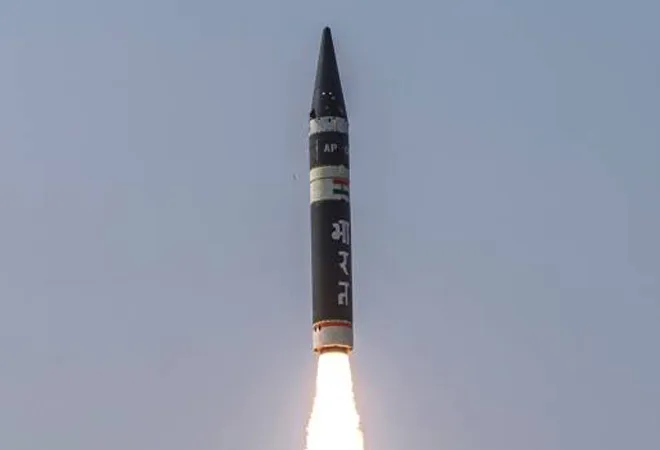-
CENTRES
Progammes & Centres
Location
While India’s missile thought is certainly evolving, it is yet to be seen if its flagship nuclear-oriented ballistic missiles are meant to further its conventional deterrence

On 7 June 2023, the Defence Research and Development Organization (DRDO) successfully conducted a pre-induction flight test of the Agni Prime missile, overseen by the Strategic Forces Command. The Prime is a solid-fuelled road mobile, medium-range missile (1,200-2,000 km), and the first of the new generation of missiles after the end of the Integrated Guided Missile Development Programme, making it the most accurate missile in India’s arsenal. Solely in terms of range, the Prime is not a turning point, with the Agni V already being capable of 5000+ kms. However, the projected accuracy of the missile and its new generation capabilities have fuelled existing fears of foreign observers of India that it is moving towards a counter-force-based nuclear posture (seeking to precisely target opposing nuclear infrastructure during war-fighting). Such fears have been readily dismissed by other analysts including long-time nuclear policy expert Ashley Tellis, asserting that this inference is disproportionate if drawn from the projected accuracy of the missile alone. For instance, even ballistic missiles of the United States (US), with dedicated counter-force roles (Minuteman III or Trident D5) have lesser accuracy (in the double digits) than what the DRDO claims for the newer Agni missiles. Other analysts maintain that with South Asia’s dense civilian population centres and their proximity to military bases, terms such as nuclear counter-force are of little use. Moreover, the pursuit of better accuracy and canisterization—the possibility of warheads being stored with the missiles—is not restricted to the Prime since Agni V is also a canisterised missile with high accuracy (claimed to be single digit).
Solely in terms of range, the Prime is not a turning point, with the Agni V already being capable of 5000+ kms.
This debate notwithstanding, New Delhi has shown a greater tendency in recent years to use its conventional missile arsenal to deter both Pakistan and China. It credibly triggered a fear in Islamabad in 2019 of Indian willingness to use between six to twelve missiles, unless Pakistan released the captured Indian pilot unconditionally. Following the 2020 Sino-Indian skirmishes, India moved its array of conventional missiles closer to the Line of Actual Control, replete with the BrahMos and Nirbhay cruise missiles (officially, not nuclear capable). India seeks to shore this up by inducting tactical quasi-ballistic missiles such as the Pralay, with a range of 150-500 kms. Moreover, these conventional missiles are set to be placed under a new command-level tri-service entity—the Integrated Rocket Force—in a move to at least partially mimic the PLA’s own rocket force (but without control over nuclear forces which remain under the SFC). Indeed, media reports already show India’s move to focus on building its conventional deterrent after having proven the credibility of its nuclear deterrent.
While such evolution of material capabilities certainly marks a turning point in the direction of India’s ‘missile-thought’, a key question is whether the Agni Prime itself represents a landmark development. Following every test of the Prime since 2021, analysts have almost invariably pointed to its potential of being used as an anti-ship ballistic missile (ASBM). This led to Chinese analysts specifically attempting to counter any Indian claim of the missile being a match for China’s own DF-21D ballistic missile which has a dedicated anti-ship role (reported to be the first of its kind). Given recent Chinese missile developments and its increasing presence in the Indian Ocean, there is a strong enough trigger to allow a relatively quick evolution of India’s missile thought. It is indeed in New Delhi’s interests to shore up its sea-based deterrent with a credible enough land-based missile capability. This shall bolster the anti-ship cruise-missile arsenal that New Delhi has already begun testing, with the BrahMos as its mainstay. Moreover, the DRDO has a historic reputation for “project folding”—the tendency to pitch a missile test as a technology demonstrator and immediately lobby for the next missile that incorporates the upgrades. Such a tendency was on display when the DRDO had begun pushing for the Agni VI after just a single test of the Agni V. With the DRDO having already pitched a 1,500 km range anti-ship conventional ballistic missile design to the Indian government in September 2022, it is highly likely that the Prime’s successful tests have bettered its case for a new missile.
Media reports already show India’s move to focus on building its conventional deterrent after having proven the credibility of its nuclear deterrent.
However, citing the Prime’s accuracy and manoeuvrability to suggest that it can have a dual-use (conventional/nuclear) role is a hasty assumption. The effectiveness of deterrence depends on the opponent’s perceptions of both capabilities and declared intentions. India made the choice of ditching strategic ambiguity in favour of a declared nuclear doctrine in 2003. The core feature of this document has been a counter-value-based massive retaliation posture that effectively excludes the use of nuclear weapons for war-fighting. Even those from India’s strategic community presently advocating for better preparations to meet the challenge presented by China’s rocket forces, have refrained from fully advocating dual-use for ballistic missiles given the increased ambiguity and have actively discouraged a co-mingling of nuclear and conventional forces like that by China’s PLARF. Hence, it is too early to assert that the Prime alone represents Indian willingness to assign conventional war-fighting roles to ballistic missiles that (despite capabilities) has been known for its nuclear role. Supposing that India does indeed develop the Agni Prime as a conventional anti-ship ballistic missile, given the long-standing nuclear narrative around the Agni missiles, it would inject some amount of ambiguity in New Delhi’s posture, with the opponent forced to determine the conventional or nuclear nature of an Agni launch within a reaction window ning seconds, from a state with a declared no-first-use policy.
India made the choice of ditching strategic ambiguity in favour of a declared nuclear doctrine in 2003.
However, this ambiguity would be substantially reduced if the new Integrated Rocket Force (IRF) gets control of a Prime that is exclusively for conventional use, while the SFC retains control over the existing Prime geared for nuclear payload delivery. Indeed, this would represent the strongest shift in New Delhi’s missile thought, as no other entity besides the SFC has held control of an Agni missile since the Command’s formation in 2003. Moreover, the IRF is still in the planning stages, amidst ongoing (and prolonged) efforts at theaterisation, and is usually spoken of in the context of countering Chinese actions across the LAC (first by Gen. Bipin Rawat in 2021). This latter-most aspect does not preclude the IRF from deploying ASBMs. However, the overall context would likely push New Delhi—a historically cautious actor—to overtly clarify the development of an ASBM/Conventional Agni Prime for the IRF. This would further reduce ambiguity for a state that has thus far refrained from developing ballistic missiles dedicated for conventional use, since declaring its nuclear weapons capability in 1998.
The Agni missile family itself pre-dates India’s overt declaration of its nuclear weapons capability by almost a decade, and older missiles such as the Agni V have already been explicitly touted by the DRDO for their high accuracy.
India could nonetheless look to exploit any ambiguity by making the Agni a dual-use missile in the future. This would then lead to an evolution of its nuclear doctrine (its improbability notwithstanding). States are not legally bound by their stated doctrines and capability enhancements combined with shifts in strategic thought, could trigger policy changes. However, there is scant evidence to suggest that this begins with the Prime. The Agni missile family itself pre-dates India’s overt declaration of its nuclear weapons capability by almost a decade, and older missiles such as the Agni V have already been explicitly touted by the DRDO for their high accuracy (meaning that India’s pursuit of accuracy did not necessarily begin with the new generation Prime). Moreover, whether by design or chance, the DRDO itself has refrained from explicitly outlining the Prime’s conventional capabilities following all the tests conducted thus far, unlike the Agni V whose conventional warhead tonnage the Organisation explicitly outlines. Indeed, even after an earlier test of the Prime, India’s Defence Minister reiterated how the missile strengthens India’s credible deterrence capabilities, indicating adherence to India’s traditional posture. Hence, while New Delhi’s missile thought is certainly evolving in the conventional sphere, it is yet to be seen if its flagship nuclear-oriented ballistic missiles are also deliberately meant to further its conventional deterrence.
Bashir Ali Abbas is a Research Associate at the Council for Strategic and Defense Research, New Delhi
The views expressed above belong to the author(s). ORF research and analyses now available on Telegram! Click here to access our curated content — blogs, longforms and interviews.

Bashir Ali Abbas is a Research Associate at the Council for Strategic and Defense Research, New Delhi. He is also a South Asia Visiting Fellow ...
Read More +